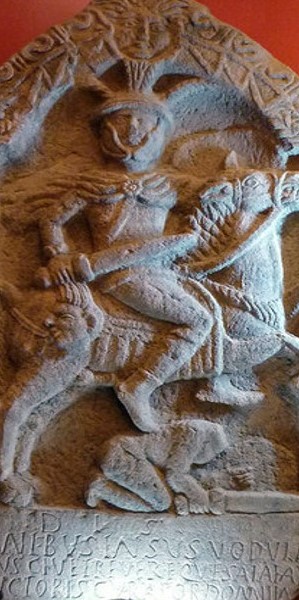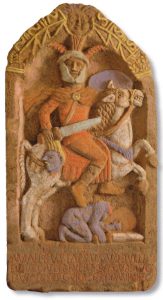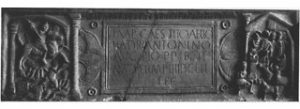
March 14, 2018, by Helen Lovatt
Latin Now: The Lancaster Cavalry Inscription
Alex Mullen considers bilingualism and violent interactions in the Lancaster Cavalry Inscription
I have been thinking again recently about the north-western Roman horse rider reliefs, which are concentrated in the Rhineland and, to a lesser extent, Britain (now boasting over 20), and have a primarily military focus. My favourite is that of Insus, found in Lancaster in 2005. The tombstone has been dated to c. AD 100 and its relief depicts a proud-looking mounted eques brandishing the head of a decapitated naked enemy who is kneeling below. The tombstone was discovered around 8 m from the Roman road leading south from the fort. Ironically, given the featured decapitation, Insus’s head has been separated from the rest of the scene in one of the two major fragments. It reads:
Dis | Manibus Insus Vodulli | [fil]ius ciue(s) Treuer eques alae Aug(ustae) | [t(urma)] Victoris curator
‘To the shades. Insus, son of Vodullus, citizen of the Treveri, cavalry man of the cavalry regiment Augusta, [troop] of Victor, curator.’ (Roman Inscriptions of Britain vol. III 3185)
Insus, a citizen of the Treveri, whose main population centre was Augusta Treverorum, modern Trier (Germany), stands out with an impressive plumed helmet, a cloak fanned out in the wind fastened by a rosette brooch, and a chunky sword in his right hand. His horse, also neatly kitted out, rears up and bears its teeth. Compared to the crouched figure, still gripping his sword, but with his eyes firmly closed in his decapitated head, the Treverian exudes movement and power.
The closest comparison to this Lancaster carving can be found in the Ribchester inscription-less rider stone, found in 1876, in which the rider, this time with spear rather than sword and no beheaded adversary, and horse are so similar that some have suggested the same sculptor produced both. The representation of a beheaded adversary is unusual, with only a couple of other examples of decapitation in iconography attested anywhere from Roman Britain; the closest parallel in Britain for the decapitation may be the Bridgeness ‘distance slab’ which shows a rider plus lance and four adversaries, including one decapitated in one of the two aedicula on either side of the inscription (Roman Inscriptions of Britain vol. I 2139).
Insus can be compared with his comrade Apollinaris, also from Trier, whose epitaph, found in the eighteenth century in the excavation of a cellar in Pudding Lane (now Cheapside), Lancaster, closely parallels that of Insus, though no associated iconography is attested (the stone is only known from a manuscript drawing).
Dis Mani|bus | L(ucius) Iul(ius) Apol |linaris | Trever an(norum) | XXX eq(ues) al|ae Au[g(ustae)] |h(ic) [s(itus) e(st)]
‘To the shades. Lucius Iulius Apollinaris, the Treveran, 30 years old, cavalry man of the cavalry regiment Augusta lies buried here.’ (Roman Inscriptions of Britain vol. I 606)
Both Insus and Apollinaris presumably joined the ala on the Continent before it was transferred to Britain. Insus is not a Roman name and its presentation here in non-tria nomina format and with no reference to veteran status may suggest that Insus has been killed whilst still serving. The most straightforward assumption is that Insus has died in Britain and that the headless enemy is a Briton. Given what we know about bilingualism in the north-western provinces, it is likely that someone named Insus, son of Vodullus, from Gaul in c. AD 100 came from a family that was at least partly Celtic-speaking. Trier was capital of Gallia Belgica and we know that the Celtic languages of northern Gaul were closely related to the British Celtic spoken in Britannia. This Treveran citizen, who is proudly presented in a north-western Roman military and Latin guise, would perhaps have found much more in common linguistically and culturally with the beheaded Briton than this portrayal might lead us to believe. Our work on multiple identities and bilingualism in the Roman empire can sometimes be neglectful of the violence and trauma of some of the changes that pitted communities against one another. This monument is a reminder of some of those violent entanglements.
For more information on Alex Mullen’s ERC-funded project Latin Now see here.
Further reading:
Bull, S. 2007. Triumphant Rider: the Lancaster Roman Cavalry Tombstone. Lancashire Museums. See pp. 39–51 of this volume for an overview of other horse-rider tombstones and fragments found in Britain.
No comments yet, fill out a comment to be the first



Leave a Reply